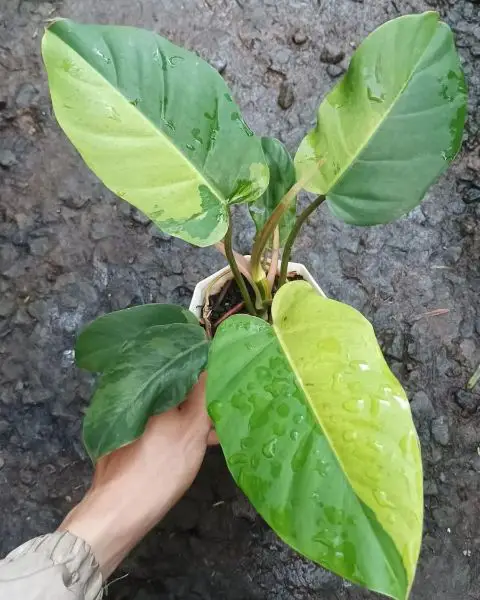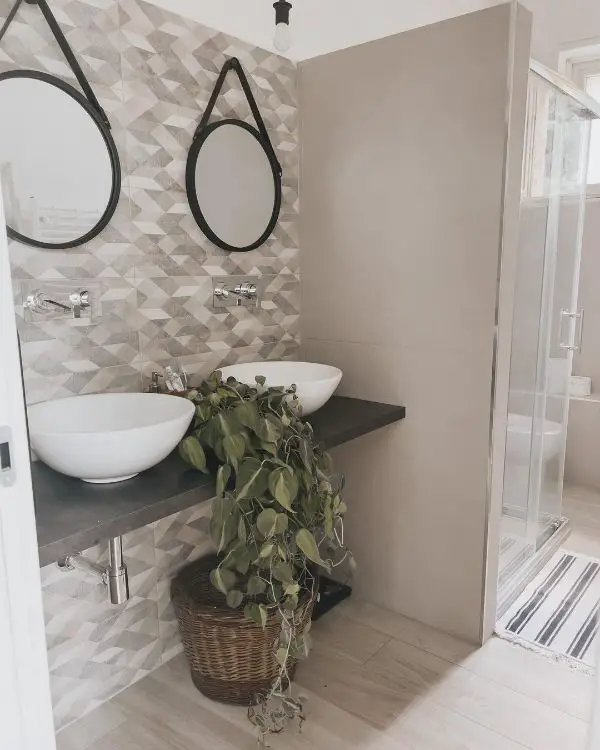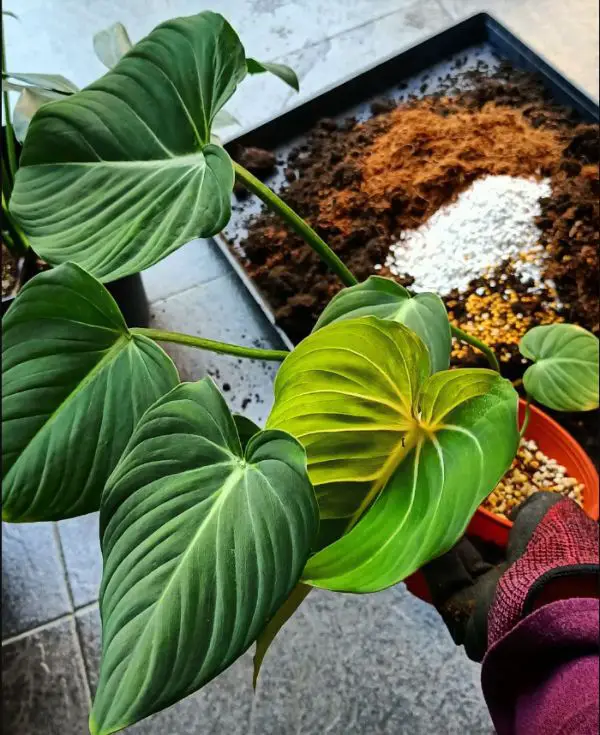When it comes to keeping your plants healthy and flourishing, one of the most important things to remember is humidity. Different plants thrive in different levels of humidity, so it’s important to do your research before you buy.
What level of humidity is ideal for a Philodendron?
Philodendrons are native to the tropical rainforests of South America, so they’re used to humidity levels of 80% or higher. In fact, they prefer it! If you can keep your Philodendron in an environment with quite high humidity, it will be happier and healthier.
The ideal range is between 65 to 80 percent, though that could dip to 55 percent overnight.
Humidity levels in most homes range from 40 to 60 percent. Although the plants will put up with it, I like to maintain them closer to their natural range so that I can get the benefits of their maximum growth.
Many species can withstand lower humidity levels, although Philodendrons can suffer if the air is too dry. It is best to increase humidity levels if you want to cultivate a strong and flourishing Philodendron.
Do Philodendrons like humidity?
Philodendrons are native to tropical America, where they thrive in hot, muggy weather. When we keep them as houseplants, if we have the same growth conditions, they will grow best.
Let’s first examine why humidity is such a significant issue for Philodendrons. Humidity is so important to the health and development of plants,
Plant transpiration rates are influenced by dampness. This is so that plants may breathe through stomata, which remain closed under low humidity levels.
Too little humidity or too much humidity and lack of transpiration will slow down photosynthesis, which has an impact on the plant’s growth.
Your plant will begin to show indications of stress if the humidity is too low. The plant struggles to absorb adequate nutrients when transpiration rates rise.
Brown leaves are likely to be the first thing you notice, followed by yellowing of the leaf margins. Both the leaves and the flowers will begin to dry as the issue worsens.
As a result of the plant retaining too much moisture, respiration is inhibited when the humidity level rises too high.
You will see that the leaves and later the flowers themselves begin to develop a gray mold. If the issue is not resolved, ultimately the leaves and stems will decay.
Therefore, even though the Philodendron is housed in a controlled environment, ensuring the right humidity is essential.

How does high and low humidity Affect the Philodendron?
High humidity
Philodendrons don’t like too much high humidity. So you must take action to reduce the amount of moisture in the air if you see that humidity is rising too high through your hygrometer or begin to notice mold symptoms on the plant.
Avoid Using Too Much Water
A significant portion of the moisture in the air around your Philodendron will come from moisture in the soil, which is released by the plant during transpiration. Between waterings, let your Philodendron somewhat dry out to help limit the amount of water that surrounds its roots.
By poking your finger into the top two inches of the potting soil, you can pretty accurately gauge how damp it is. If you can’t feel that the soil is dry to that depth, don’t water.
You should check it frequently because humidity will vary according to transpiration rates, temperatures, and soil water retention
Choose a windowsill with plenty of light and opening the window will help reduce humidity around the Philodendron. You just open it for a few minutes while it’s warm outside, with not too much sun.
Boost Air Circulation Indoors:
If the air in the space grows stale, that creates the perfect environment for the humidity level to rise.
Not only is this bad for the Philodendron, but it is also not very good for you. Simply by opening a window or two for a few hours each day, the issue can be solved.
The room’s humidity should eventually decrease as a result of the improved circulation. Additionally, the air will travel more freely in the room if the doors at each end are left open.
Using grow lights
Approximately eight hours of bright light per day are ideal for Philodendrons. You can supply the proper amount of light and reduce humidity by using grow lights.
Ordinary domestic lights do not offer a wide enough spectrum of light to meet all the needs for Philodendron’s growth.
Lack of light will cause Philodendrons to grow less effectively, which will promote a buildup of humidity.
Choose an energy-efficient light such as LED white lights.
They should be put directly over your plants and avoid letting the lights touch the plants because doing so could burn the leaves.
For optimum results, use a timer in addition to them.
Grow lights are not always necessary. Your Philodendrons may already receive enough natural light, or you may just need to think about using them during the shorter winter days.
Choose the proper soil:
Even if the humidity is not too high, you should use a free-draining potting media because Philodendrons don’t like to have their feet wet.
By adding fifty percent perlite to quality potting soil for indoor plants. While still giving your priceless plant a sufficiently moist atmosphere, the water will drain away swiftly.
Keep in mind that potting soil will retain moisture better if it contains high amounts of peat or coconut fiber.
Low Humidity
Philodendrons are easy-to-grow houseplants that will reward you with leaves for many years. Many people don’t realize that Philodendrons are tropical plants that love humidity. When you live in a dry climate, or your home is heated in the winter, your Philodendron will suffer. If you notice any of the following signs, your Philodendron may be telling you it needs more humidity:
- The leaves are starting to turn brown and curl up.
- The plant is becoming more susceptible to pests and diseases.
- The plant looks overall yellow and sickly.
If you see any of these signs, try increasing the humidity around your plant.
Misting for your Philodendrons
Spraying a little water to give the leaves with a squeegee bottle has long been the standard practice.
As the liquid evaporated, it would condense on the leaves, raising the relative humidity.
According to the new studies, the humidity is only elevated for a very brief period of time before returning to its previous level.
The process makes the moist leaves more susceptible to issues like mold and decay, which are typically associated with high humidity.
Using humidifiers
The air is more humid thanks to these devices. Buy a humidifier that is appropriate for your room’s size. It is advised to use a humidifier because it can increase the humidity levels and make them last longer.
You can precisely control the humidity level by positioning them close to your Philodendron.
This is the simplest and most efficient way to add humidity to the area around your indoor plants, especially when the humidity falls below 50%.
Grouping Philodendrons together
This is a quick but efficient approach to increasing the humidity around that island or group of plants. Their collective respiration adds moisture to the air, which makes the microclimate less dry.
Left on a gravel tray
You can also stand your plant on a gravel tray, which is a fairly simple approach. Put gravel or pebbles in a tray or plant saucer, and then add just enough water to nearly cover the material you’ve chosen. The humidity rises as the water evaporation does so, but there is little danger of the root system becoming soggy.
Taking plants to the bathroom
Sometimes placing your tropical plants in the bathroom will dramatically increase humidity. The steam from your shower or when you shower, use water will provide your plant with the humidity it needs to grow.

Using indoor mini greenhouses
Investing in an indoor mini-greenhouse is a great method to give your houseplants more humidity.
They are made of clear plastic or framed glass. Both a humidifier for the plants and a decorative item for your home.
It serves as a decorative item for your home and ensures the plants have proper humidity and offer the appropriate growing conditions in terms of temperature.
Using a moss pole
You might place surround your Philodendron with a moss pole to add some moisture.
The plant may also be supported by a moss pole, which will heighten the plant and aid in its growth.
Additionally, it aids in the development of aerial roots that improve the Philodendron’s general growth.
Moss poles are available in a variety of sizes, so you may choose one that meets your needs.
Check temperature
The ideal temperature for Philodendrons is between 56 and 90 °F (13 and 32 °C).
Greater temperatures in your home might also mean higher humidity levels if there is moisture to be absorbed, such as from wet potting soil, your fish tank, or water buildup in the plant saucers.
This requires your attention, so keep an eye on your moisture meters.
On the other hand, we frequently use heating and stoves to warm the space during the chilly winter months. This may produce a heated, dry environment with low humidity.
You may also like: Brown spots on philodendron leaves & Effective Solutions
Humidity suitable for philodendron species
There are hundreds of kinds of stunning leaf plants in the genus Philodendron. Philodendrons are excellent for bringing natural beauty to your house because of their normally huge, glossy, green foliage. There are two varieties of Philodendrons to pick from vining and non-climbing, and both are common houseplants renowned for their simple growing patterns.
The several-foot-tall vining types typically need a support structure to climb on. Non-climbing types are ideal foliage plants for containers since they grow upright. Philodendrons generally have a rapid pace of growth.
The list of Philodendrons is rated as being capable of surviving humidity 25-50% like:
- Philodendron Scandens
- Philodendron Pertusum
- Philodendron Florida
- Philodendron Bipennifolium
- Philodendron Emerald Queen
- Philodendron Selloum
However, Philodendrons are tropical plants that recommend trying to keep the humidity around them no lower than 40%.
Conclusions
Most Philodendrons like high humidity levels, around 60-70%. If the humidity drops too low, below 50%, your plant may start to show signs of wilting. On the other hand, if the humidity is too high, above 80%, your plant may start to experience leaf yellowing and browning. Now that you know how to keep your Philodendron happy and healthy, it’s time to water it!



